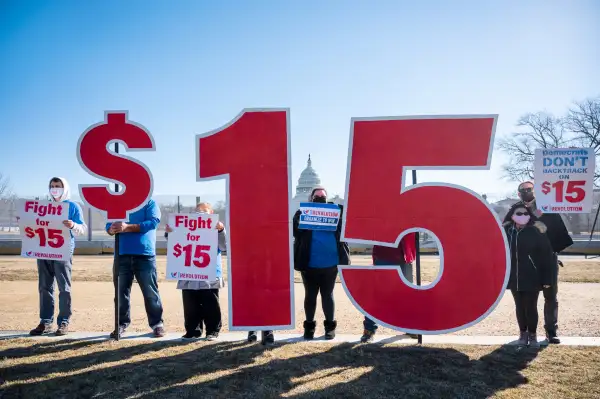4 Myths About the $15 Minimum Wage Debate

Nine years ago, hundreds of fast-food workers across New York City walked out of restaurants like McDonald's and Taco Bell in protest of the low wages they’d long been subjected to.
They wanted a raise: to $15 an hour, up from the $8.90 the average New York City food service worker made at the time. It wasn't an immediate victory (labor advocates credit the Seattle suburb of SeaTac, Washington as the first U.S. city to add — and pass — a $15 minimum wage on a ballot measure a year later). But it did cement the issue in the national consciousness.
President Joe Biden and Democratic lawmakers tried to include a provision to raise the federal minimum wage to $15 in the COVID-19 relief package currently moving through Congress, but the effort failed due to procedural reasons. They vowed to continue the fight. Today the federal minimum wage sits at $7.25 an hour, a figure that hasn’t changed since 2009.
The “Fight for $15” movement has had some blockbuster successes — as of this writing, nine states and Washington D.C. have passed laws bumping up their minimum wage requirements to $15 by 2025. (New York City, for its part, enacted a $15 minimum wage for workers employed by businesses with 11 or more employees in 2018). But there's still a lot of confusion around who, exactly, benefits from those hikes.
Here are the four biggest myths surrounding the debate today.
Myth: A $15 minimum wage is contentious
Congress may be divided on the merits of a higher federal minimum wage, but American citizens aren’t. In 2019, two-thirds of Americans supported raising the minimum wage to $15 an hour, according to a Pew Research Center survey.
The COVID-19 pandemic, which has had a disproportionate effect on low-wage frontline workers, has made people even more receptive to a wage hike, says Tsedeye Gebreselassi, director of work quality at the National Employment Law Project (NELP).
That includes red-state voters as much as those living in liberal parts of the country. Florida, which swung Republican in the last two presidential elections, also voted in November to increase its minimum wage from $8.56 to $10 by September 30, 2021, and to continue to bump it up by $1 each year until 2026.
“There’s a broad understanding that the country needs to do more for workers going out there so more people can stay home," Gebreselassi says. "It has more momentum now than ever before."
Myth: A $15 minimum wage is super generous
Research shows that part-time workers are more likely to earn at or below the federal minimum wage (the latter of which include tipped employees and workers with disabilities, two groups that are especially vulnerable to wage exploitation) than those who work full-time. Raising the pay of these workers, many of whom are having a particularly tough time finding steady work in the wake of the pandemic, wouldn’t lead to a life of luxury — but it would help them put food on the table.
“When the pandemic hit, in week one or two, people were already standing in lines waiting for food," Gebreselassi says. "Wages are so low that it's impossible to save. People are foregoing basic necessities."
Raising the wage floor to $15 would also have a lasting impact on major U.S. public safety net programs, according to a January 2021 study from the UC Berkeley Labor Center. Nearly half (47%) of the families who would receive a direct pay bump are enrolled in programs like Medicaid and the Supplemental Nutrition Assistance Program (SNAP). Raising the minimum wage to $15 would ease the financial burden of those programs, the study says.
Myth: A $15 minimum wage would mostly help teenagers
Young workers are more likely to earn a minimum wage compared to older workers. But the vast majority of people who would benefit from an increase are adults ages 18 and older, according to the Economic Policy Institute (EPI). That includes the parents of 14.4 million children, the agency says.
This is especially true in pockets of the U.S. where the cost of living is the highest. In the state of New York, the typical worker earning less than $15 is a woman over 25 with some college education, according to NELP. More than half are women, and more than 75% are persons of color.
Nationwide, 31% of African Americans and 26% of Latinos would get a raise if the federal wage were increased to $15.
If a $15 federal minimum wage was mandated, "The workers who would receive a pay increase are overwhelmingly adult workers, most of whom work full time in regular jobs, often to support a family,” according to the EPI.
Myth: A $15 minimum wage is the end goal
Gebreselassi and other workplace rights advocates say the U.S. has made big strides in the fight for a fair minimum wage.
Still, “We have a long way to go to catch up to where we need to be,” she says.
Remember, this is gradual: Even states that have approved a $15 minimum wage are phasing it in over the next several years. And In the meantime, the hourly wages workers earn today have less value than they did 40 years ago. Accounting for inflation, the federal minimum wage was $10.47 per hour in 1979, according to USA facts — $3.22 more than it is in 2021.
“It’s very clear that there are places in the country where people need a lot more than $15 an hour to make ends meet," Gebreselassi says. "$15 is a starting point.”
More from Money:
Would Student Debt Cancellation Shrink the Racial Wealth Gap?
A Third of Americans Plan to Raid Their Retirement Savings to Make Ends Meet
The 10 Best Pet Insurance Companies of 2021
